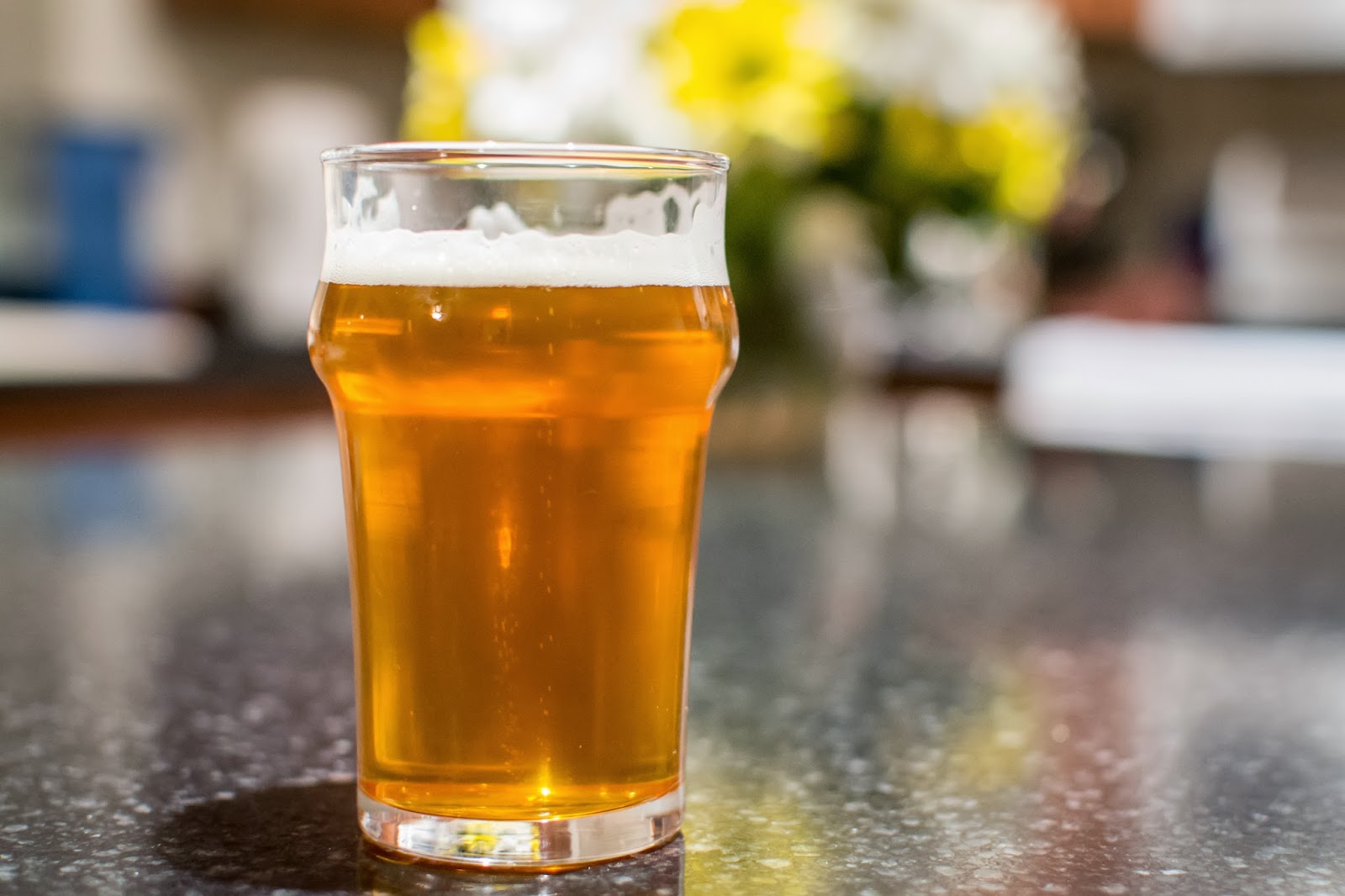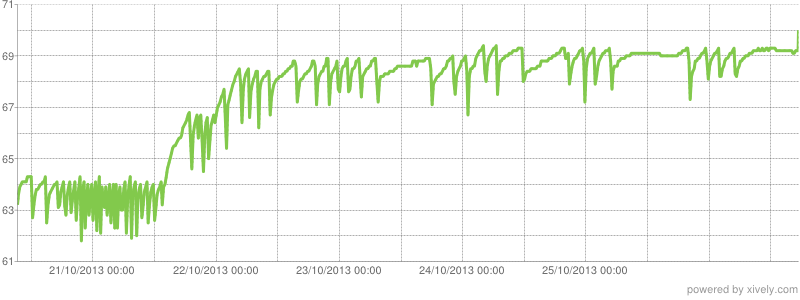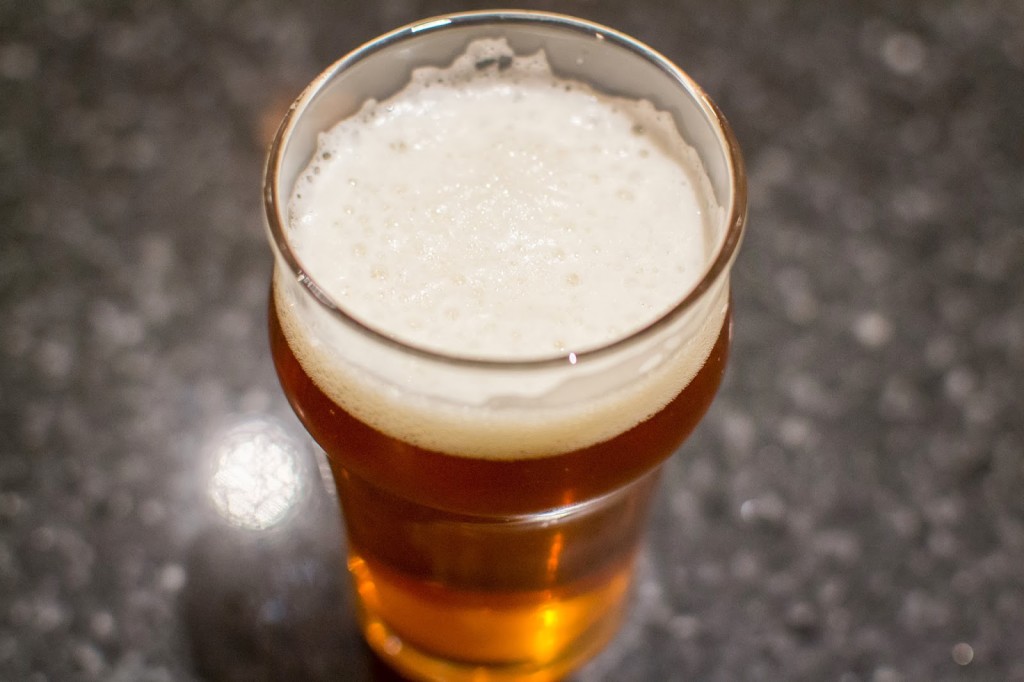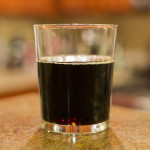Bertus IPA

Between brewing a lot of clone IPAs, and then beers for the wedding, it’s been awhile since I’ve brewed an IPA of my own. The timing is good, as now is also a good time to finish using up the remainder of my 2012 hops before the new 2013 ones come in. Also, we’re going to be camping this Thanksgiving with the in-laws, so I’m going to make this a 10 gallon batch, and bring a keg out for the weekend.
I decided early on I wanted this beer to be decidedly west-coast. Light on the crystal, fairly light in color, north of 7% ABV, and tons of hops. I like some Munich and Victory in my IPAs to give the malt a little backbone, and I’m a big fan of English crystal malts. I look for every excuse to use English crystal over domestic these days. Choosing what hop profile I want is the harder part for me; I’m like a kid in a candy store with too many options.
I finally settled in on making Centennial and Simcoe the feature hops for this beer, with the goal of getting a really big citrus aroma. From there I decided on some Mosaic for the fruitiness, and CTZ and Amarillo for complexity. I didn’t overload the kettle with hops, but I’m piling them on pretty heavy in the dry hops (4.25oz per 6gal.)
I had a nice brew day outside. Our gorgeous fall continues, and I’m enjoying my brew days more and more. I mashed in at 152* for 60 minutes, sparged, and boiled for 60 minutes. This beer got a 15 minute hot whirlpool before I kicked on the chilling water, and brought the beer down to 62-64F (It was one of the two, I really don’t remember.) I split a big starter of WLP090 in two, and pitched it along with a healthy dose of O2 before buttoning up the fermenters.
 Brewed: 10-19-13
Brewed: 10-19-13
Dry Hopped: 10-26-13
Kegged: 11-2-13
OG: 1.065
FG: 1.011
ABV: 7.1%
IBU: 75
12 Gallons
25lbs 2-row
2lb Munich
20oz Carastan
8oz Victory
Mash @ 152*
2oz Apollo @ 90
2oz Centennial @ 30
2oz ea Centennial/Simcoe @ 15
2oz ea Centennial/Simcoe & 1oz ea Mosaic/CTZ @ 0
Dry Hops (per fermenter):
DH1: .5oz ea Centennial/Simcoe & .75oz CTZ
DH2: .5oz ea Centennial/Simcoe & .75oz ea Amarillo/Mosaic
WLP090 – Super San Diego Yeast

I started these beers where I start all my WLP090 fermentations, at 17.2C. A quick word on my fermentation temps. I say I set the fridge at 17.2C (63F), but there’s a 0.8C temp differential. The fridge will climb to 18C (64.4F) before kicking on and cooling to 17.2C. So basically, I start these beers right at 64F, and go up from there. Anyway, these fermented pretty quickly, as 090 always does. After a week, I racked before fermenters to CO2-purged kegs, and tossed in the dry hops for another week. Finally, I crashed them both, and racked to clean kegs with some gelatin.
Surprising, this beer took a little longer to ‘come together’ than I thought it would. It was pretty tasty right off the bat, but it wasn’t until around 10 days in the keg did the hop flavors ‘clean up’ (for lack of a better term). The appearance is exactly what I was shooting for. A very clear pale orange color with a big white head. It could be a little clearer, but nothing I’m stressing over. The aroma is huge citrusy hops. Orange and grapefruit. It’s a fairly complex hop aroma, but the citrus is really what hits you in the face. Flavor is pretty close to the same. Lots of heavy citrus flavors, some crackery malt character, and a clean bitterness at the end.
Overall, it’s an excellent IPA, and there isn’t much I’d change. Next time around I’ll probably toss a little Cascade in the dry hop to add some floral qualities, but that’s about it. This is definitely a recipe I’m going to keep working on tweaking. I’m sending this beer along with the Milk Chocolate Stout to a couple competitions, so we’ll see what some judges have to say. I want an IPA that is brewed to my taste, and one I’m happy to call my own. We’re pretty damn close with this one though!




Scott, another great looking recipe. I can't wait to give this one a try. Did you end up combining the two dry hop additions into one? If not, what was the schedule? Thanks for the terrific blog!
Thanks. Nope, they were separate additions. 4 days on the one, and 3 days on the second.
Do you still use a small fridge to control ferm temp? Currioys now that your are doing 10 gal batches.
I upgraded to a full-size fridge in the garage when we moved. Bigger garage with more room. The little mini/dorm fridge did a rocking job for a number of years though.
You can see the new one in the last picture of this post: https://www.bertusbrewery.com/2013/07/getting-back-on-horse.html
Scott,
I'm not a fan of Victory/biscuit at all. Would I sub. it with something, for this recipe, or would it be best to just omit it? THX
It's just there for some malt complexity. Feel free to omit all together, or sub for something you like.
Hey Scott, first congrats on being a newlywed!!! Second, your blog is the best; keep it up!!! Third, I’d like your opinion/thoughts on this dry hop schedule for 5 gal batch. DH #1 {.4 oz Apollo, .5 Simcoe, .5 Citra, .5 Amarillo} DH#2 {1 oz Nelson, 1 oz Galaxy}
Scott- I'm curious about your dry hopping method…so you rack to empty kegs to dry hop? When you say they are purged with CO2 do you transfer sealed or just fill the keg with a bunch of CO2 before transferring, also when you transfer to kegs with gelatin do you used a closed system to transfer? Maybe you've already addressed this in a previous post, thanks!
Thanks!
That looks pretty good to me. Expect something similar to Stone's Enjoy By with the Nelson and Galaxy combo. The rest of the hops should add complexity as well. Looks good.
Yup, rack to empty keg. I basically think of it as a 'secondary'. I just kill the keg with a bunch of CO2 and purge a number of times. Transferring sealed would probably be the better way to go though.
I then rack from that keg (secondary), to a clean keg that was again purged with CO2.
Closed transfers would probably be much better. I need to make a keg to keg jumper one of these days.
Scott,
I've been working on an IPA recipe to call my own as well. Right now I am trying to keep it simple but I've got something similar going on with my grains. I'm using 48% american 2 row, 48% MO, and 4% biscuit. I'm thinking about getting a little white wheat or honey malt in there as well based on how this one comes out.
My IPA is going into a purged keg with the dry hops tonight.
One thing I've gone back to is mid boil additions. In the last few months I had been doing 60 minute and then 0 minute additions (whirlpool, hop stand, etc). While this makes a REALLY hoppy beer with intense bitterness and intense hope flavor/aroma, I can taste that there is quite a bit missing in the middle of the taste. I noticed you have a 30 minute addition as well, were you thinking along the same lines?
Really enjoy your blog, keep it up!
Chris
To be honest, I don't think it added much to the final beer. I was really just trying to burn through my stock of Centennial before the new 2013 harvest hits the market. For simplicities sake, I'll probably cut that addition in the next batch.
I'm not sure what you're finding missing in your IPAs? Maybe a bit more complex malt bill would help?
My model is green flash west coast IPA. I don't want to clone it (which I have), but that beer is just so solid.
http://www.homebrewtalk.com/f12/can-you-brew-recipe-green-flash-west-coast-ipa-175363/
The clone brew is a pretty simple malt bill, but I think the intense hop flavor and complexity comes from the layering of hops throughout the boil. At least that's my theory… Also, that dry hop is crazy… crazy good!
I am a bit confused about Simcoe. Some people say its citrusy, some say dank…is it both depending on when you add it? Can a hop be both citrusy and dank?
Simcoe to me smells like grapefruit and pine trees. I think what you pair it with brings out different qualities.
Hello Scott
Can you explain how you purge a keg when transferring? Do you purge while transferring and/or purge after transfer? To me it only makes sense to transfer as normal and then purge. Your thoughts and procedure explanation would be great.
Cheers
Scott – big fan of your blog, keep up the awesome work! What's the reasoning behind transferring to a second keg? Couldn't you just remove the dry hops, add your finings, and carbonate in the same keg? I've heard of other homebrewers doing this, but not sure if its worth the extra effort.
this got me thinking about dry hopping, see what you think:
http://www.homebrewtalk.com/f13/what-point-2-dry-hop-additions-444742/
I have been loving a batch of my micro IPA, 2 row, Golden promise, Vienna, Pilsner, Caramalt, Carapils, Wheat. Used Pacific Jade to bitter as the low amounts of Cohumolone gives the softer bitterness that complements the lower ABV.I also used Amarillo but also used a touch of Riwaka. Mashed high it works fine with WLP001 so would assume 090 similar. Used this recipe for inspiration as its fantastic – http://8wired.co.nz/our-brews/semiconductor
I purge it with CO2 before I transfer. Just to the point I'm reasonably confident that the keg is filled with mostly CO2. Then I rack into the keg, and purge it again. The idea is that the wort is in contact with mostly CO2 the whole time.
Thanks!
Ya, you could definitely do that. I just threw the pellets in loose, which then requires a clean keg to rack to. I do a stainless dry hopper that I use from time to time. It works well. It just depends on what mood I am in.
Ya, my experience dry hopping has been that multiple additions yield more aroma. I really can't explain why, but I can definitely say splitting up my dry hops and adding them over several days yields more hop aroma for me. =/
When racking do you siphon in the large opening?
Yup. It's probably a better idea to rack into the liquid out post if you wanted to rig that up though.
Scott-
I've looked at most of your recipes and it looks like you're going from grain to glass in just under a month usually? I try and wait at least 2 months – not sure why? Have you found that the beer is "young" after that short of a time frame?
Ya, usually under a month for hoppy styles. I brew a lot of hoppy beers, and I find they are best young. My malty beers definitely do well with 4-5 weeks of cold conditioning, but kegerator space often doesn't dictate I can do that.
Where is your beer spending the extra time? In the keg, in the bottle, in the primary?
In the keg usually, I only have 2 kegs, and i'm usually tapping one while just kegging the other. To solve this problem i've purchased a 2nd tap.
Probably not the best page to ask question, but where do you buy bulk simcoe? Keep up good work mister.
Scott,
Why use Carastan (35 L or so) instead of something lighter, such as crystal 20? Do you have experience with using 20 in a Pale or IPA, and if so, what are your thoughts? TIA
How was the judges feedback? Clearly you are happy with the new but did they bring anything to the table? So far in have used your malt radios from another beer you brewed (blonde ale) and have gotten no less than a 37.5 so I'm curious to see what the master does with IPA. I Mainly used it for fruit beer.
Hey Scott Ive been following your blog for about a year now, and do you have a go to water profile for your IPA's? I use a modified version of Randy Mosher's Pale Ale profile built from RO. I was just wondering since you brew alot of hoppy beers,
John
He did a post earlier on water which can be found here:https://www.bertusbrewery.com/2012/02/water-chemistry-how-to-build-your-water.html. I don't know if he stuck to that for this batch but it has served me well in the past
Hey there, love the blog. Dumb question what's your process for stepping down the amount of hops so the IBU's even out? If I halve everything I'm up at 110 IBU's. I need to check the AA% on what I have, I could be wrong I just took the default from Beersmith
EDIT: I mean for a 6 G batch
Check out nikobrew.com for bulk hops. They have simcoe for 20 bucks a pound.
Very good, but id didn't place in either. It's been a few months, but I want to say it scored 39 in one and 41 or 42 in the other. Both comps had something like 40 IPAs entered. It happens :shrug:
Just cut everything in half across the board.
Hi Scott. Your recipe shows 75 IBUs but when I put this into Beersmith at 12G I get 110 IBUs. Did you calculate 75 IBUs with these hop amounts? This seems like a big discrepancy . Thanks! Your blog is a great resource for us!
IBU calculators are useless for IPAs in my opinion. Pliny calcs out at like 240IBU, but tests at like 90 in the lab. It's just really hard to saturate wort with more than 70-80 IBUS.
Thanks for posting late hop/dry hop addition amounts that work with gelatin finings. The last IPA I made using this recipe as a template was super hoppy and clear! m/
Hey Scott, love your blog! I want to try one of your recipes, and was thinking this would be the best place to start. But first I wanted to place a bulk hops order. Unfortunately, the vendor who I was going to order from is out of Centennial. Obviously, that hop is a major factor in this recipe. Do you think I could replace the Centennial with a different hop or hop combination (maybe half Cascade / half Columbus) or would I be better off going with another recipe and waiting until I can get Centennial to brew this?
Hey – sorry to bug you with a question but I'm brewing this in two weeks time and the last beer I made (your east valley IPA), while really good, was overpowered by the bitterness – I think probably to do with me not getting the best out of the hops as I don't purge with CO2 etc. So when I brew this I was thinking of changing the 60min addition to just 15g (Apollo) and the 30min addition to just 20g (Centennial). Any idea whether this would ruin the beer or whether that's a good way to go about reducing the IBU slightly? Thanks in advance if you/anyone gets chance to reply! Cheers – Chris
Thanks for this recipe. I am most of the way through my first keg of the batch, and it is a fantastic IPA. I'll definitely brew it again and try some of your others.